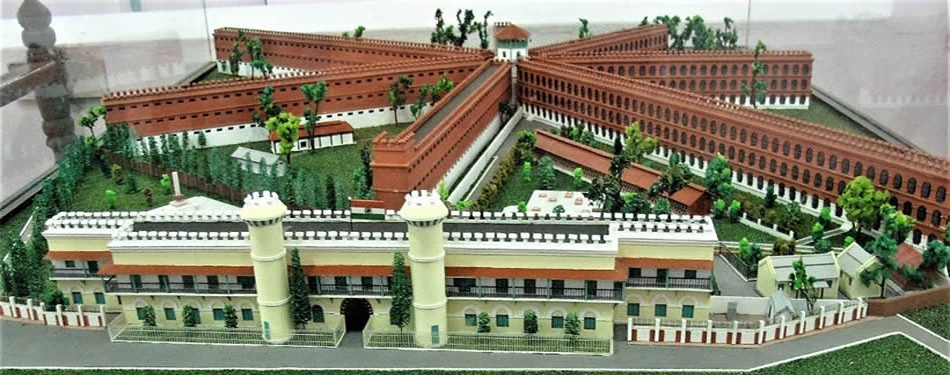Guardians of the Andaman: A Journey into the Past and Present of Andaman Jail

The Andaman Cellular Jail, often referred to as 'Kala Pani' or the 'Black Waters', stands
as a somber reminder of India's struggle for independence. This colossal structure,
which has been a silent witness to the unspeakable atrocities meted out to freedom
fighters, is not just an edifice made of bricks and mortar. It symbolizes the resilience
and sacrifice of those who fought for India's freedom. In this blog, we journey through
the past and present of the Andaman jail, exploring its history and its ongoing role as
a guardian of the Andaman.
The Origins of Andaman Cellular Jail
The cellular jail Andaman was constructed by the British during the late 19th century.
Designed to exile political prisoners from the Indian mainland, the jail was a testament
to the British Empire's resolve to quash the burgeoning freedom movement. The
construction of the Andaman jail began in 1896 and was completed in 1906. The isolated
location of the Andaman Islands made it an ideal spot to cut off the freedom fighters
from the outside world, thereby breaking their spirit.
The Design and Architecture of Cellular Jail Andaman
The architecture of the Andaman Cellular Jail was meticulously planned to inflict maximum
solitude and hardship. The jail was initially a seven-winged structure, each wing
radiating from a central watchtower in a star-like pattern. This design ensured that
inmates in one wing could not communicate with those in another. The cells were small
and lacked proper ventilation, designed to inflict physical and psychological torture on
the inmates.
Cellular Jail History: A Chronicle of Suffering
The Cellular Jail History is a tale of immense suffering and cruelty. Freedom fighters
incarcerated here were subjected to inhuman conditions and brutalities. They were forced
to perform hard labor like oil grinding and rope making, often leading to severe
physical and mental exhaustion. The tales of heroism and suffering of inmates like Veer
Savarkar and Batukeshwar Dutt are well-documented and form an integral part of Cellular
Jail's history.
The Role of Andaman Jail in India’s Freedom Struggle
The Andaman Cellular Jail played a crucial role in India's freedom struggle, not just as
a prison but as a symbol of resistance. Despite the inhumane conditions, the spirit of
the inmates remained unbroken. They secretly organized literacy classes, discussed
revolutionary ideas, and even managed to smuggle out messages to the mainland. The jail
thus became a crucible where the flame of freedom was kept alive against all odds.
The Transformation of Cellular Jail Andaman
Post-independence, the Andaman Cellular Jail underwent a significant transformation.
Recognizing its historical significance, the government preserved it as a national
memorial. Today, it stands as a museum and a testament to the sacrifices made by India's
freedom fighters. The jail now hosts a sound and light show that narrates its history,
attracting thousands of tourists every year.
Cellular Jail: A Tourist Destination with a Dark Past
Visiting the Cellular Jail in Andaman is an emotional experience. Walking through the
corridors and cells, one can almost hear the echoes of the past - the pain, the
suffering, and the indomitable spirit of the inmates. The jail also houses a gallery
with photographs and exhibits that chronicle the freedom struggle and the role of the
jail in it.
The Legacy of Cellular Jail in Contemporary Times
The Cellular Jail stands today not just as a historical monument but as a symbol of the
price paid for India's freedom. It serves as a reminder of the atrocities of colonial
rule and the indomitable spirit of those who fought against it. The jail has become a
pilgrimage site for those who wish to pay homage to the heroes of India’s freedom
struggle.
The Guardian of the Andaman
The Andaman Cellular Jail is aptly termed the 'Guardian of the Andaman.' It guards not
just the physical territory but also the memories and legacy of India’s freedom
struggle. It stands as a guardian of history, reminding us of the sacrifices made for
the freedom we enjoy today.
The Andaman Cellular Jail is more than just a historical monument; it's an emotional
journey into India's colonial past and freedom struggle. As we walk through its
corridors, we are reminded of the price of freedom and the resilience of the human
spirit. The Andaman jail, as a guardian of the past, continues to inspire and educate
future generations about the sacrifices made for India’s independence. It stands as a
testament to the undying spirit of those who fought for freedom and the resilience of
the human will against all odds.
